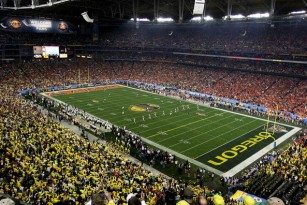As data traffic broke records at the first ever college football playoff championship between the Oregon Ducks and Ohio State Buckeyes at AT&T Stadium in Arlington, Texas, AT&T tested and unveiled a few new products that could lead the way to a more interactive experience for customers.
The National Championship event broke the previous data record of 3.3 terabytes from last year’s Super Bowl. According to AT&T, the 85,689 fans in attendance used 4.93 TB of mobile data on the AT&T hosted Wi-Fi network for Monday night’s game. That is the equivalent of 18.1 million social media posts and photos.
In addition to the Wi-Fi data used, customers also used an additional 1.41 TB of wireless data on the stadium’s distributed antenna system-based network.
AT&T also said that data traffic was up 107% on Wi-Fi and DAS usage compared to the average Dallas Cowboy’s game in 2014. The final data tally is probably even higher as these numbers do not take into account other carriers’ data usage.
Monday night’s game also saw the debut of a new enclosure for AT&T’s DirectSeat Wi-Fi equipment deployment. The original design was created by AT&T Wi-Fi in Austin. The AT&T Foundry in Plano, Texas helped create the physical prototype. The two groups partnered up to get the product into production in time for the National Championship game.
The water proof enclosure was created by AT&T Wi-Fi to house the standard Cisco 2524 antennas in an aesthetically pleasing way. The enclosures were used throughout the lower-level seating to maximize the field-level customers’ Wi-Fi experience during the game.
The enclosure is AT&T’s next generation enclosure built on experience gained from other stadium and arena deployments.
Another new piece of technology AT&T used at the game was LTE Broadcast. RCR Wireless News got a demonstration of the technology enabling mobile devices to stream content in a more spectrally efficient way than current mobile video technologies. AT&T teamed up with Ericsson for the network hardware and Qualcomm for the firmware. They demoed the technology on the Samsung Galaxy Note 3 with ESPN content on an app created by MobiTV. The technology allows the customer to seamlessly switch between streaming multicast content with no lag or latency.
Qualcomm was an early pioneer in the one-way video streaming space with its ill-fated MediaFLO subsidiary that operated a broadcast service across a number of markets using 700 MHz spectrum holdings. While limited in the amount of content that could be delivered, as well as by limited device availability, prior to it being shuttered the service did show that it was possible.
More recently, Verizon Wireless has been trialing its LTE Multicast service, which is based on the LTE Broadcast standard, at a number of sporting events, including last year’s Indianapolis 500 car race and at last year’s Super Bowl.
Stay tuned for an inside look at AT&T’s Foundry in Plano, Texas from RCRtv’s “Digs” series.

